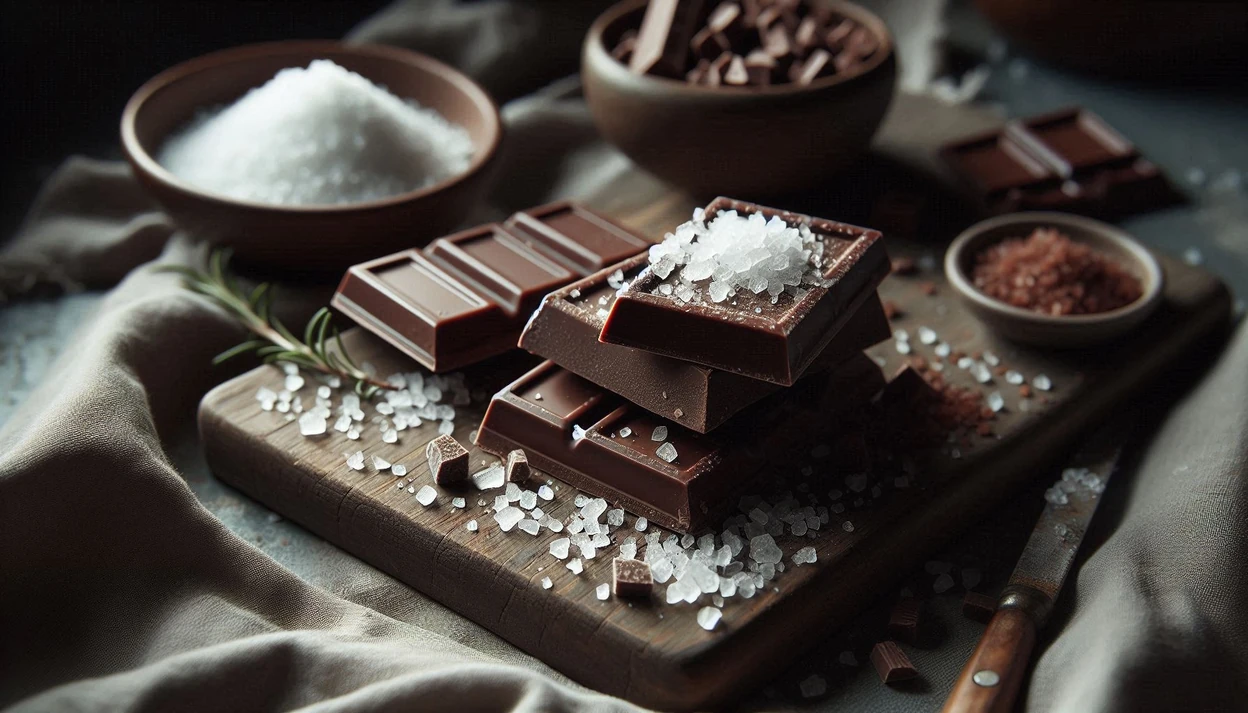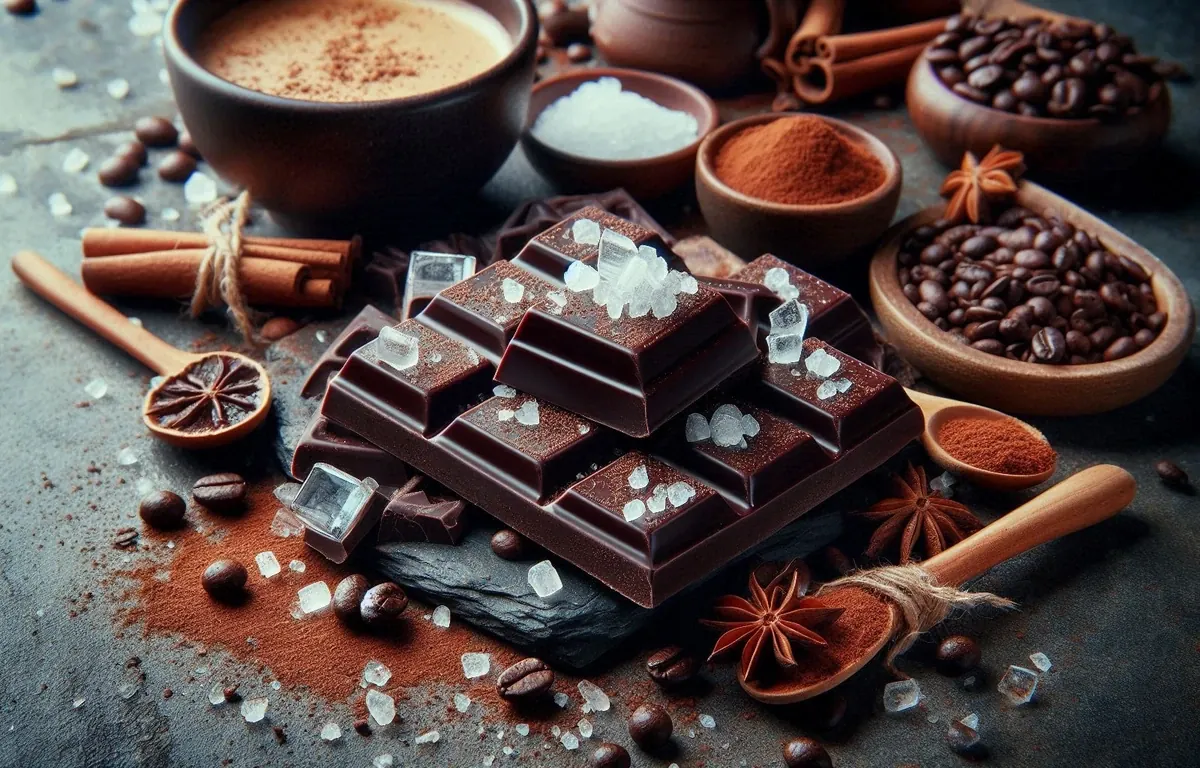The Taste That Breaks the Rules
The world of sweetness has long been orderly, predictable, and somewhat monotonous. We knew that chocolate meant pleasure, warmth, childhood, and safety. It was supposed to be sweet, soft, familiar. Yet sometimes even in the most ordinary things, revolutions happen — quiet, aromatic, unnoticeable. And such a revolution was the pairing of chocolate and salt. It felt almost forbidden: a sharp grain of salt in the deep darkness of cocoa. It sounds simple, but it stirs a storm of sensations. Once you try it — there’s no going back to “just sweet.”
Chocolate with salt doesn’t adapt to expectations — it breaks them. It provokes, plays, opens new depth in taste. At first, you sense the gentle bitterness of cocoa, then comes a wave of sweetness, and suddenly — a subtle hit of salt crystal that melts away, leaving a warm aftertaste. This contrast works because it resembles life itself — with its many facets and unpredictable transitions from joy to calm, from sharpness to tenderness. That’s why this flavor touches the subconscious so deeply — it’s honest.
Perhaps the secret lies in the fact that we’re tired of excess. Of desserts that “scream” sweetness. Of artificial perfection that leaves no space for truth. When salt appears in chocolate — everything falls into place. The flavor awakens. It breathes. And it feels as if, for the first time, you’re tasting real chocolate — not its sugary shell. It’s more than a gastronomic experiment — it’s a gesture of maturity, a return to simplicity that carries meaning.
Interestingly, even those who initially approach this combination with skepticism often admit: it fascinates. Because in every piece — there’s a hint of unpredictability. And perhaps that’s exactly what we seek today — not perfection, but authenticity; not uniformity, but contrast that reminds us: pleasure has salt.
The Chemistry of Pleasure
Every taste is more than a sensation — it’s chemistry. And chocolate with salt is one of the best examples of how nature and science work together to create something brilliant in its simplicity. On the surface of the tongue are thousands of taste receptors, each responsible for a specific signal: sweet, salty, bitter, sour, or umami. When we eat plain chocolate, the zone responsible for pleasure is activated. But when salt enters the mix — two more systems awaken. And the brain starts to play music.
Salt not only enhances sweetness — it reveals hidden flavor nuances. Think about it: pure chocolate has a naturally bitter base, especially dark chocolate rich in cocoa beans. Salt softens that bitterness but doesn’t erase it — it leaves room for drama. Like in wine, where a touch of acidity adds life. Or in perfume, where a note of wood deepens the sweetness. The salt crystal in chocolate is that same “stroke” — without it, the taste would be flat.
From a scientific point of view, sodium in salt affects protein receptors on the tongue, changing their sensitivity. This creates the “flavor-opening” effect — when chocolate seems richer, warmer, more aromatic. In the brain, this moment registers as something new, fresh, intriguing. That’s why we don’t just “like” this taste — we’re drawn to it, like to a small mystery we want to rediscover each time.
Some chocolatiers say that pairing salt with cocoa is like a conversation between two strong personalities. If one dominates — there’s no harmony. But if they listen to each other — something third is born: deeper, more complex, truer. In this harmony lies the secret chemistry of pleasure. And perhaps that’s why a piece of salted chocolate never feels trivial — each time it reveals something new within you.

The Culture of Contrast
Though we perceive chocolate with salt as a modern trend, the idea itself is ancient. The Maya, who first discovered cocoa, combined it with spices, pepper, salt, and even corn flour. For them, cocoa wasn’t a dessert — it was a ritual drink of power: bitter, intense, sacred. They believed salt purified taste and amplified the energy of cocoa. Perhaps that’s why humanity has always sensed that true pleasure can’t be one-dimensional.
In modern times, the French reimagined this idea. Chocolatier Pierre Hermé and pastry chef Jacques Genin in the 1990s began adding sea salt from Brittany to caramel and chocolate. Their desserts caused both shock and admiration — they broke the main culinary rule: salty must stay salty. Scandinavians followed, adding smoked salt to dark chocolate; the Japanese used sea salt with seaweed notes; Americans experimented with textures, creating chocolate where salt crystals crunched between the teeth. Thus was born a new aesthetic — the aesthetic of contrast.
Over time, chocolate with salt ceased to be just a trend. It became a mark of refined taste. In cafés and patisseries worldwide, it appeared beside classics like truffles, coffee, and wine. It was served at tastings, mindfulness evenings, paired with champagne or whisky. Because this flavor isn’t merely pleasant — it’s meditative. It teaches slowness. In that moment when salt touches your tongue, time seems to stop — and you simply feel. The depth, the harmony, the tiny “dialogue” of taste that reminds you: life is beautiful when there’s a bit of salt in it.
Today, a bar of sea-salt chocolate is more than a product. It’s a symbol of a new gastronomic mindset. There’s no excess, no gloss — only honesty and openness. And perhaps that’s why we keep returning to this taste — not as to a dessert, but as to a story we want to hear again.
Balance and Philosophy
Sweet and salty — it’s not just a flavor opposition. It’s a metaphor of our time. We live in extremes: high speed, noise, the pursuit of perfection — in body, career, everything. But what if true harmony lies in balance? In that “pinch of salt” that makes life real, imperfect, alive. That’s why chocolate with salt has become not only a gastronomic phenomenon but a symbol of a new philosophy — the philosophy of embracing contrast.
As in life, in taste it’s important not to eliminate opposites but to let them coexist. We can’t feel sweetness without knowing bitterness. We can’t appreciate harmony without experiencing chaos. Salt in chocolate reminds us of this. It whispers: “Don’t fear mixing. Don’t fear being complex.” And this simplicity — is the highest form of elegance. True beauty isn’t about perfection — it’s about being alive.
Today, chocolate with salt appears in mindfulness practices, in conscious-eating rituals, in gastronomic collaborations with a philosophical undertone. It’s become more than a product — it’s a moment. A moment when you allow yourself to pause, break a piece, inhale the aroma, feel the salt crystal on your tongue — and remember: everything you need for happiness is already here. A bit of bitterness, a bit of sweetness, a bit of salt — and that’s the true flavor of life.
So next time you feel a grain of salt in your chocolate — smile. It’s a reminder that opposites aren’t enemies. They can be best friends. Because in their meeting, harmony is born — a taste you’ll never forget.

